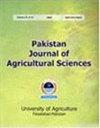An assessment and prediction of milk production traits of Chinese Jersey cattle at different parities
IF 0.6
4区 农林科学
Q3 AGRICULTURE, MULTIDISCIPLINARY
引用次数: 0
Abstract
The purpose of this study was to analyze milk producing traits, correlation between milk production and parities of Chinese Jersey cattle, and to make accurate prediction. For this purpose, samples for this study were taken from a large-scale breeding farm of Chinese Jersey cattle and chemically and statistically analyzed. The results of ANOVA and LSD showed that milk yield, protein percentage, somatic cell, urea nitrogen and other lactating traits of Jersey cattle of different parities were significantly different. LSD results explored that milk fat percentage decreased gradually, as the parity increased from second to third parity, while there was no difference in milk fat percentage in third and fourth parity. Similarly, protein percentage in milk was highest in second parity and then it decreased in third parity and lowest protein percentage was observed in fourth parity. Results of coefficient of variation explored that milk yield, protein and somatic cells reached the maximum value at parity 2, and the coefficient of variation of milk fat percentage and urea nitrogen reached the maximum value at parity 4. There was a significant negative correlation between milk yield and milk fat percentage, protein percentage, somatic cell and urea nitrogen in all parities. There was a positive correlation between milk fat percentage and protein percentage, somatic cell and urea nitrogen. There was a positive correlation between the protein rate and somatic cells, which was significant only at the 1st and 4th parity. There was a significant positive correlation between urea nitrogen and somatic cells at parity 1, and a negative correlation at parity 2, 3 and 4. Results of realistic estimates of achievable prediction accuracy of lactating traits showed that the amplitude of realistic estimate of prediction of milk yield, milk fat percentage, protein percentage, somatic cell and urea nitrogen in four parities were -0.65%-23.41%, -3.23%-3.92%, -3.19%-2.94%, -44.43%-29.81% and -7.83% ~ 3.97%, respectively. Based on results it is concluded that a complex correlation between the lactating traits of Jersey cattle exist and parities can significantly affect milk yield, milk protein, somatic cells and urea nitrogen of Chinese Jersey cattle中国泽西牛不同性别产奶性状的评价与预测
本研究的目的是分析中国泽西牛的产奶特性、产奶量与产仔数的相关性,并做出准确的预测。为此,本研究的样本取自中国泽西牛的大型养殖场,并进行了化学和统计分析。方差分析和LSD结果表明,不同性别泽西牛的产奶量、蛋白质百分比、体细胞、尿素氮等泌乳性状存在显著差异。LSD结果发现,随着产次从第二次到第三次的增加,乳脂率逐渐下降,而第三次和第四次的乳脂率没有差异。同样,牛奶中的蛋白质百分比在第二产次时最高,然后在第三产次时下降,在第四产次时观察到最低的蛋白质百分比。变异系数的结果表明,产奶量、蛋白质和体细胞在第2胎次达到最大值,乳脂率和尿素氮的变异系数在第4胎次达到最高值。奶牛产奶量与乳脂率、蛋白质率、体细胞和尿素氮呈显著负相关。乳脂率与蛋白质率、体细胞和尿素氮呈正相关。蛋白率与体细胞呈正相关,仅在第1次和第4次产程时才有显著性。尿素氮与体细胞在产程1时呈显著正相关,在产程2、3和4时呈负相关。泌乳性状可实现预测准确度的现实估计结果表明,四个母系的产奶量、乳脂率、蛋白质率、体细胞和尿素氮的现实估计幅度分别为-0.65%-23.41%、-3.23%-3.92%、-3.19%-2.94%、-44.43%-29.81%和-7.83%~3.97%。结果表明,泽西牛泌乳性状与产仔数之间存在复杂的相关性,对中国泽西牛的产奶量、乳蛋白、体细胞和尿素氮有显著影响
本文章由计算机程序翻译,如有差异,请以英文原文为准。
求助全文
约1分钟内获得全文
求助全文
来源期刊

Pakistan Journal of Agricultural Sciences
AGRICULTURE, MULTIDISCIPLINARY-
CiteScore
1.80
自引率
25.00%
发文量
18
审稿时长
6-12 weeks
期刊介绍:
Pakistan Journal of Agricultural Sciences is published in English four times a year. The journal publishes original articles on all aspects of agriculture and allied fields.
 求助内容:
求助内容: 应助结果提醒方式:
应助结果提醒方式:


